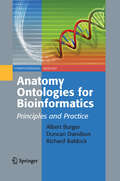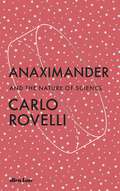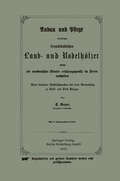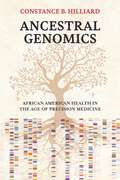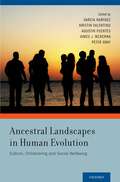- Table View
- List View
Anatomy of the Monocotyledons Volume X: Orchidaceae (Anatomy of Monocotyledons)
by William Louis SternFor many years orchids have been among the most popular of ornamental plants, with thousands of species and hybrids cultivated worldwide for the diversity, beauty, and intricacy of their flowers. This book is the eagerly-awaited result of over 30 years of research into orchid anatomy by one of the world's leading authorities and is the first comprehensive publication on orchid anatomy since 1930. It describes the structure and relationships among the cells and tissues of leaves, stems, and roots, and is organized systematically in line with the taxonomy expressed in the OUP Genera Orchidacearum Series. The book is fully illustrated with over 100 photomicrographs and numerous original line drawings. This latest addition to the Anatomy of the Monocotyledons Series is an essential reference text for orchid scientists and research students and will also be of interest and use to a broader audience of orchid enthusiasts.
Anatomy of the voice (Large Print)
by RnibThis is a nine-page document with diagrams showing the organs responsible for voice production in humans. There is a locator dot shown, which will be at the top left of the page when the image is the correct way up. The diagrams are as follows: * Key to the anatomy of the voice * Anatomy of the voice - side view vertical cross section of the head * Key to vocal chords * Vocal chords - horizontal cross section * Vocal chord movement - two horizontal cross section diagrams * Pharynx - side view vertical cross section of the head * Larynx - side view vertical cross section of the head * Nasal cavity - side view vertical cross section of the head * Oral cavity - side view vertical cross section of the head
Anatomy of the voice (UEB Contracted)
by RnibThis is a nine-page document with diagrams showing the organs responsible for voice production in humans. There is a locator dot shown, which will be at the top left of the page when the image is the correct way up. The diagrams are as follows: * Key to the anatomy of the voice * Anatomy of the voice - side view vertical cross section of the head * Key to vocal chords * Vocal chords - horizontal cross section * Vocal chord movement - two horizontal cross section diagrams * Pharynx - side view vertical cross section of the head * Larynx - side view vertical cross section of the head * Nasal cavity - side view vertical cross section of the head * Oral cavity - side view vertical cross section of the head
The Anatomy of Violence: The Biological Roots of Crime
by Adrian RaineAdrian Raine is one of the world's leading authorities on the minds of the violent, the criminal, the dangerous, the unstable. An Anatomy of Violence is the culmination of his life's work so far, offering the latest answers to some of the most difficult questions: what are the causes of violence? Can it be treated? And might it one day be stopped?Are some criminals born, not made? What causes violence and how can we treat it? An Anatomy of Violence introduces readers to new ways of looking at these age-old questions. Drawing on the latest scientific research, Adrian Raine explains what it reveals about the brains of murderers, psychopaths and serial killers. While once it was thought upbringing explained all, and subsequently explanations shifted to genetics, Raine goes to great pains to explain that anti-social behaviour is complex, and based on the interaction between genetics and the biological and social environment in which a person is raised. But the latest statistical evidence between certain types of biological and early behavioural warning signs is also very strong. Through a series of case studies of famous criminals, Raine shows how their criminal behaviour might be explained on the basis of these new scientific discoveries. But the conclusions point to a host of philosophical and moral issues. What are the implications for our criminal justice system? Should we condemn and punish individuals who have little or no control over their behaviour? Should we act preemptively with people who exhibit strong biological predispositions to becoming dangerous criminals? These are among the thorny issues we can no longer ignore as our understanding of criminal behaviour grows.Praise for Adrian Raine's The Psychopathology of Crime: 'An extremely informative, thoughtful and illuminating book ... a tour de force', David P Farrington, Psychological Medicine Adrian Raine is the Richard Perry University Professor in the Departments of Criminology, Psychiatry, and Psychology at the University of Pennsylvania. For the past 35 years, his research has focused on the neurobiological and biosocial bases of antisocial and violent behavior, and ways to both prevent and treat it in both children and adults.
Anatomy Ontologies for Bioinformatics: Principles and Practice (Computational Biology #6)
by Albert Burger Duncan Davidson Richard BaldockThis book provides a timely and first-of-its-kind collection of papers on anatomy ontologies. It is interdisciplinary in its approach, bringing together the relevant expertise from computing and biomedical studies. The book aims to provide readers with a comprehensive understanding of the foundations of anatomical ontologies and the-state-of-the-art in terms of existing tools and applications. It also highlights challenges that remain today.
Anatomy & Physiology
by OpenStaxHuman Anatomy and Physiology is designed for the two-semester anatomy and physiology course taken by life science and allied health students. The textbook follows the scope and sequence of most Human Anatomy and Physiology courses, and its coverage and organization were informed by hundreds of instructors who teach the course. Instructors can customize the book, adapting it to the approach that works best in their classroom. The artwork for this textbook is aimed focusing student learning through a powerful blend of traditional depictions and instructional innovations. Color is used sparingly, to emphasize the most important aspects of any given illustration. Significant use of micrographs from the University of Michigan complement the illustrations, and provide the students with a meaningful alternate depiction of each concept. Finally, enrichment elements provide relevance and deeper context for students, particularly in the areas of health, disease, and information relevant to their intended careers.
Anatomy & Physiology: A Complete Introduction: Teach Yourself
by David Le VayAnatomy & Physiology: A Complete Introduction is designed to give you everything you need to succeed, all in one place. It covers the key areas that students are expected to be confident in, outlining the basics in clear, jargon-free English and providing added-value features like summaries of key books and even lists of questions you might be asked in your seminar or exam.The book uses a structure that mirrors the way anatomy & physiology is taught on many university courses, providing a comprehensive introduction to the structure and function of the human body. Extensively illustrated, the book also covers modern methods of investigation, relevant aspects of modern genetics, sports injuries, environmental and evolutionary considerations, and the physiological aspects of AIDS. Topics covered include: cells and tissues; the skeleton; muscle; body coverings and body systems; the upper limb; the lower limb; the abdomen; the thorax; the head and neck; basic biophysics and chemistry; foodstuffs and vitamins; digestion; absorption, utilization and storage of digested food; blood, lymph and reticuloendothelial (immune) system; the heart and circulation; respiration; excretion; nervous system and sense organs; the endocrine system; reproduction and development; environmental considerations; evolution.Anatomy & Physiology employs the 'Breakthrough Method' to help you advance quickly at any subject, whether you're studing for an exam or just for your own interst. The Breakthrough Method is designed to overcome typical problems you'll face as learn new concepts and skills.- Problem: "I find it difficult to remember what I've read."; Solution: this book includes end-of-chapter summaries and questions to test your understanding.- Problem: "Lots of introductory books turn out to cover totally different topics than my course."; Solution: this book is written by a university lecturer who understands what students are expected to know.
Anatomy & Physiology All-in-One For Dummies (+ Chapter Quizzes Online)
by Erin OdyaThe knee-bone’s connected to the…what was it again? From complicated Latin names to what can seem like a million-and-one things to memorize, no one's saying anatomy and physiology is easy. But, with a little help from your friends at Dummies, it doesn't have to be impossible! Anatomy & Physiology All-in-One For Dummies is your go-to guide for developing a deep understanding of the parts of the human body and how it works. You’ll learn the body's structures and discover how they function with expert help from the book's easy-to-use teaching features. You can even go online to access interactive chapter quizzes to help you absorb the material. With this book, you'll: Get a grip on key concepts and scientific terminology used to describe the human body Discover fun physiology facts you can apply to everyday life both inside and outside the classroom Learn how the body's different systems interact with one another So, if you’re looking to ace that next test, improve your overall grade, reduce test anxiety, or just increase your confidence in the subject, grab a copy of Anatomy & Physiology All-in-One For Dummies. It's your one-stop, comprehensive resource for all things A&P!
Anatomy & Physiology All-in-One For Dummies (+ Chapter Quizzes Online)
by Erin OdyaThe knee-bone’s connected to the…what was it again? From complicated Latin names to what can seem like a million-and-one things to memorize, no one's saying anatomy and physiology is easy. But, with a little help from your friends at Dummies, it doesn't have to be impossible! Anatomy & Physiology All-in-One For Dummies is your go-to guide for developing a deep understanding of the parts of the human body and how it works. You’ll learn the body's structures and discover how they function with expert help from the book's easy-to-use teaching features. You can even go online to access interactive chapter quizzes to help you absorb the material. With this book, you'll: Get a grip on key concepts and scientific terminology used to describe the human body Discover fun physiology facts you can apply to everyday life both inside and outside the classroom Learn how the body's different systems interact with one another So, if you’re looking to ace that next test, improve your overall grade, reduce test anxiety, or just increase your confidence in the subject, grab a copy of Anatomy & Physiology All-in-One For Dummies. It's your one-stop, comprehensive resource for all things A&P!
Anatomy & Physiology, Fifth Edition
by Helen McGuinnessExpand your students' knowledge of anatomy and physiology and how it applies to practical treatments with the new edition of this bestselling book by Helen McGuinness.- Boost exam chances with essential support for the new Beauty Therapy qualifications - Prepare for success with exam-style questions and tips on technique- Cover all anatomy and physiology requirements in Beauty Therapy, with updated information for the latest Level 2 and Level 3 qualifications- Feel confident that core material is covered by Helen McGuinness's expert authorship, in the book's fifth edition- Combine this text with the new accompanying workbook and revision guide (sold separately), which includes activities for learner self-study, revision and exam practice
Anatomy & Physiology Workbook For Dummies with Online Practice
by Erin Odya Pat DuPreePractice your way to a high score in your anatomy & physiology class The human body has 11 major anatomical systems, 206 bones, and dozens of organs, tissues, and fluids—that’s a lot to learn if you want to ace your anatomy & physiology class! Luckily, you can master them all with this hands-on book + online experience. Memorization is the key to succeeding in A&P, and Anatomy & Physiology Workbook For Dummies gives you all the practice you need to score high. Inside and online, you'll find exactly what you need to help you understand, memorize, and retain every bit of the human body. Jam packed with memorization tricks, test-prep tips, and hundreds of practice exercises, it’s the ideal resource to help you make anatomy and physiology your minion! Take an online review quiz for every chapter Use the workbook as a supplement to classroom learning Be prepared for whatever comes your way on test day Gain confidence with practical study tips If you’re gearing up for a career in the medical field and need to take this often-tough class to fulfill your academic requirements as a high school or college student, this workbook gives you the edge you need to pass with flying colors.
Anatomy & Physiology Workbook For Dummies with Online Practice
by Erin Odya Pat DuPreePractice your way to a high score in your anatomy & physiology class The human body has 11 major anatomical systems, 206 bones, and dozens of organs, tissues, and fluids—that’s a lot to learn if you want to ace your anatomy & physiology class! Luckily, you can master them all with this hands-on book + online experience. Memorization is the key to succeeding in A&P, and Anatomy & Physiology Workbook For Dummies gives you all the practice you need to score high. Inside and online, you'll find exactly what you need to help you understand, memorize, and retain every bit of the human body. Jam packed with memorization tricks, test-prep tips, and hundreds of practice exercises, it’s the ideal resource to help you make anatomy and physiology your minion! Take an online review quiz for every chapter Use the workbook as a supplement to classroom learning Be prepared for whatever comes your way on test day Gain confidence with practical study tips If you’re gearing up for a career in the medical field and need to take this often-tough class to fulfill your academic requirements as a high school or college student, this workbook gives you the edge you need to pass with flying colors.
Anaximander: And the Nature of Science
by Carlo RovelliNow widely available in English for the first time, this is Carlo Rovelli's first book: the thrilling story of a little-known man who created one of the greatest intellectual revolutions Over two thousand years ago, one man changed the way we see the world.Since the dawn of civilization, humans had believed in the heavens above and the Earth below. Then, on the Ionian coast, a Greek philosopher named Anaximander set in motion a revolution. He not only conceived that the Earth floats in space, but also that animals evolve, that storms and earthquakes are natural, not supernatural, that the world can be mapped and, above all, that progress is made by the endless search for knowledge. Carlo Rovelli's first book, now widely available in English, tells the origin story of scientific thinking: our rebellious ability to reimagine the world, again and again.Translated by Marion Lignana Rosenberg
Anbau und Pflege derjenigen fremdländischen Laub- und Nadelhölzer welche die norddeutschen Winter erfahrungsgemäß im Freien aushalten: Unter besonderer Rücksichtsnahme über deren Verwendung zu Wald- und Park-Anlagen
by C. W. GeyerAncestors in Our Genome: The New Science of Human Evolution
by Eugene E. HarrisThe complete DNA molecules comprising the human genome were deciphered two decades ago. With this discovery began a remarkable genomic voyage back in time yielding a new science of human evolution. We are just beginning to unravel our full genomic history and answering age-old questions about how and when we evolved. For the first time, we are finding our ancestors in our genome and gleaning tantalizing clues about our past. Molecular anthropologist Eugene E. Harris now gives us an updated and expanded version of the original Ancestors in Our Genome. Written from the perspective of population genetics, and in simple terms, his book traces human origins back to our earliest human ancestors and explains how our genome has adapted as we spread to colonize new regions on Earth. Harris's book reveals the latest insights into our relationships with our extinct cousins, the Neandertals and Denisovans, and describes where, when and to what extent we mated with them, probing the good and bad consequences of this.
Ancestors in Our Genome: The New Science of Human Evolution
by Eugene E. HarrisThe complete DNA molecules comprising the human genome were deciphered two decades ago. With this discovery began a remarkable genomic voyage back in time yielding a new science of human evolution. We are just beginning to unravel our full genomic history and answering age-old questions about how and when we evolved. For the first time, we are finding our ancestors in our genome and gleaning tantalizing clues about our past. Molecular anthropologist Eugene E. Harris now gives us an updated and expanded version of the original Ancestors in Our Genome. Written from the perspective of population genetics, and in simple terms, his book traces human origins back to our earliest human ancestors and explains how our genome has adapted as we spread to colonize new regions on Earth. Harris's book reveals the latest insights into our relationships with our extinct cousins, the Neandertals and Denisovans, and describes where, when and to what extent we mated with them, probing the good and bad consequences of this.
The Ancestor's Tale: A Pilgrimage to the Dawn of Life
by Yan Wong Prof Richard DawkinsA fully updated edition of one of the most original accounts of evolution ever written, featuring new fractal diagrams, six new 'tales' and the latest scientific developments.THE ANCESTOR'S TALE is a dazzling, four-billion-year pilgrimage to the origins of life: Richard Dawkins and Yan Wong take us on an exhilarating reverse journey through evolution, from present-day humans back to the microbial beginnings of life. It is a journey happily interrupted by meetings of fellow modern animals (as well as plants, fungi and bacteria) similarly tracing their evolutionary path back through history. As each evolutionary pilgrim tells their tale, Dawkins and Wong shed light on topics such as speciation, sexual selection and extinction.Written with unparalleled wit, clarity and intelligence; taking in new scientific discoveries of the past decade; and including new 'tales', illustrations and fractal diagrams, THE ANCESTOR'S TALE shows us how remarkable we are, how astonishing our history, and how intimate our relationship with the rest of the living world.
Ancestors, Territoriality, and Gods: A Natural History of Religion (The Frontiers Collection)
by Ina Wunn Davina GrojnowskiThis books sets out to explain how and why religion came into being. Today this question is as fascinating as ever, especially since religion has moved to the centre of socio-political relationships. In contrast to the current, but incomplete approaches from disciplines such as cognitive science and psychology, the present authors adopt a new approach, equally manifest and constructive, that explains the origins of religion based strictly on behavioural biology. They employ accepted research results that remove all need for speculation. Decisive factors for the earliest demonstrations of religion are thus territorial behaviour and ranking, coping with existential fears, and conflict solution with the help of rituals. These in turn, in a process of cultural evolution, are shown to be the roots of the historical and contemporary religions.
Ancestral Genomics: African American Health in the Age of Precision Medicine
by Constance B. HilliardA leading evolutionary historian offers a radical solution to racial health disparities in the United States.Constance B. Hilliard was living in Japan when she began experiencing joint pain. Her doctor diagnosed osteoarthritis—a common ailment for someone her age. But her bloodwork showed something else: Hilliard, who had never had kidney problems, appeared to be suffering from renal failure. When she returned to Texas, however, a new round of tests showed that her kidneys were healthy. Unlike the Japanese doctor, her American primary care provider had checked a box on her lab report for “African American.” As a scholar of scientific racism, Hilliard was perplexed. Why should race, which experts agree has no biological basis, matter for getting accurate test results?Ancestral Genomics is the result of Hilliard’s decade-long quest to solve this puzzle. In a masterful synthesis of evolutionary history, population genetics, and public health research, she addresses the usefulness of race as a heuristic in genomic medicine. Built from European genetic data, the Human Genome Project and other databases have proven inadequate for identifying disease-causing gene variants in patients of African descent. Such databases, Hilliard argues, overlook crucial information about the environments to which their ancestors’ bodies adapted prior to the transatlantic slave trade. Hilliard shows how, by analyzing “ecological niche populations,” a classification model that combines family and ecological histories with genetic information, our increasingly advanced genomic technologies, including personalized medicine, can serve African Americans and other people of color, while avoiding racial essentialism.Forcefully argued and morally urgent, Ancestral Genomics is a clarion call for the US medical community to embrace our multigenomic society.
Ancestral Landscapes In Human Evolution: Culture, Childrearing And Social Wellbeing
by Peter Gray Darcia Narvaez Kristin Valentino Agustin Fuentes James J. McKennaAncestral Sequence Reconstruction
by David A. LiberlesAncestral sequence reconstruction is a technique of growing importance in molecular evolutionary biology and comparative genomics. As a powerful tool for testing evolutionary and ecological hypotheses, as well as uncovering the link between sequence and molecular phenotype, there are potential applications in a range of fields. Ancestral Sequence Reconstruction starts with a historical overview of the field, before discussing the potential applications in drug discovery and the pharmaceutical industry. This is followed by a section on computational methodology, which provides a detailed discussion of the available methods for reconstructing ancestral sequences (including their advantages, disadvantages, and potential pitfalls). Purely computational applications of the technique are then covered, including whole proteome reconstruction. Further chapters provide a detailed discussion on taking computationally reconstructed sequences and synthesizing them in the laboratory. The book concludes with a description of the scientific questions where experimental ancestral sequence reconstruction has been utilized to provide insights and inform future research. This research level text provides a first synthesis of the theories, methodologies and applications associated with ancestral sequence recognition, while simultaneously addressing many of the hot topics in the field. It will be of interest and use to both graduate students and researchers in the fields of molecular biology, molecular evolution, and evolutionary bioinformatics.
Ancestry of humans and apes (tactile)
by RnibA chart showing how great apes and lesser apes descend from a common ancestor. This page has a note saying that it should be read sideways.
Ancestry of humans and apes (tactile)
by RnibA chart showing how great apes and lesser apes descend from a common ancestor. This page has a note saying that it should be read sideways.
Ancestry Reimagined: Dismantling the Myth of Genetic Ethnicities
by Kostas KampourakisRecent social and political psychological research indicates that increased access to ancestry testing has strengthened the notion of genetic essentialism among some groups, or the idea that our biology ties us to particular ethnic identities. This can boost a sense of cultural pride and prosocial behaviors among communities that are perceived to be similar. In the worst-case scenarios, however, this phenomenon can contribute to deeper social woes like misinformation, anti-science agendas, and even social hatred among those who believe in racial superiority. Using research from both the social sciences and the genetics literature as support, Ancestry Reimagined establishes realistic expectations about what we can learn from our DNA as a foundation for examining the psychological impact of ancestry testing, including the differences between how this information is perceived versus its reality. With this book, Dr. Kampourakis flexes his muscles as an esteemed interdisciplinary science educator and author to challenge these traditional social constructs, using the current genetic testing science as a myth busting tool. Kampourakis argues that DNA ancestry testing cannot reveal a person's true ethnic identity because ethnic groups are socially and culturally constructed. In 10 accessible chapters, he explains the assumptions underlying the scientific study of ancestry, and the resulting paradoxes that are often overlooked. What the study of human DNA mostly shows is that human DNA variation is continuous, and it is not possible to clearly delimit ethnic groups based on DNA data. As a result, we all are members of a huge, extended family, and not of genetically distinct ethnic groups. What ancestry tests can provide are probabilistic estimations of similarities between the test-takers and particular reference populations. This does not devalue the results of these tests, however, because they can indeed provide some valuable information to people who may not know much about their ancestors. In fact, what the tests are very good at doing is finding close relatives, and this is perhaps why the whole enterprise should be rebranded as family, not ancestry, testing. Ultimately, this book reveals that genetic essentialism, biological ethnic identities, racial superiority, and similar social constructs are scientifically unsupported.
Ancestry Reimagined: Dismantling the Myth of Genetic Ethnicities
by Kostas KampourakisRecent social and political psychological research indicates that increased access to ancestry testing has strengthened the notion of genetic essentialism among some groups, or the idea that our biology ties us to particular ethnic identities. This can boost a sense of cultural pride and prosocial behaviors among communities that are perceived to be similar. In the worst-case scenarios, however, this phenomenon can contribute to deeper social woes like misinformation, anti-science agendas, and even social hatred among those who believe in racial superiority. Using research from both the social sciences and the genetics literature as support, Ancestry Reimagined establishes realistic expectations about what we can learn from our DNA as a foundation for examining the psychological impact of ancestry testing, including the differences between how this information is perceived versus its reality. With this book, Dr. Kampourakis flexes his muscles as an esteemed interdisciplinary science educator and author to challenge these traditional social constructs, using the current genetic testing science as a myth busting tool. Kampourakis argues that DNA ancestry testing cannot reveal a person's true ethnic identity because ethnic groups are socially and culturally constructed. In 10 accessible chapters, he explains the assumptions underlying the scientific study of ancestry, and the resulting paradoxes that are often overlooked. What the study of human DNA mostly shows is that human DNA variation is continuous, and it is not possible to clearly delimit ethnic groups based on DNA data. As a result, we all are members of a huge, extended family, and not of genetically distinct ethnic groups. What ancestry tests can provide are probabilistic estimations of similarities between the test-takers and particular reference populations. This does not devalue the results of these tests, however, because they can indeed provide some valuable information to people who may not know much about their ancestors. In fact, what the tests are very good at doing is finding close relatives, and this is perhaps why the whole enterprise should be rebranded as family, not ancestry, testing. Ultimately, this book reveals that genetic essentialism, biological ethnic identities, racial superiority, and similar social constructs are scientifically unsupported.



